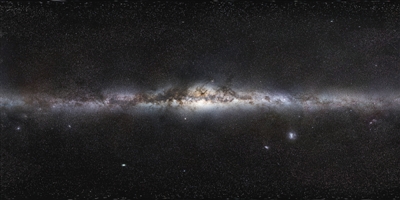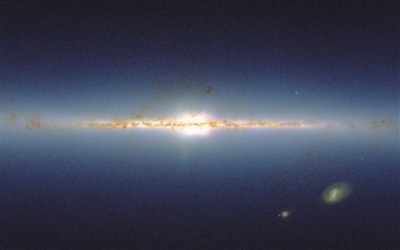


The picture shows the Milky Way observed in the infrared band. The picture is from the 2MASS Sky Survey project. The pictures are all stitched together from multiple observations. Due to the interstellar extinction in the optical band, it can be seen that the image of the Milky Way in the optical band is light and dark.
The Milky Way is like humanity’s "most familiar stranger". After more than 200 years of hard work, we still haven’t fully seen its face. A new study has brought us one step closer to the true appearance of the Milky Way.
On a clear night, looking up at the stars, you will see a milky white bright band running through the night sky, which is the home of hundreds of billions of stars, including the sun – the Milky Way.
Since more than 200 years ago, people have been trying to understand the structure of the Milky Way.
This is not simple, not only because we are in it, but also because various interstellar media interfere with people’s vision and obscure the true appearance of the Milky Way.
Recently, researchers at the National Astronomical Observatory have measured the latest hydrogen column density and optical extinction ratio in the Milky Way. This work will help to understand the interstellar medium and is a crucial step in the journey to understanding the structure of the Milky Way.
The sun is not the center of the galaxy
In the 17th century, Galileo pointed his telescope at the milky band of light in the sky and found that it was a dense region of stars. In the mid-18th century, the Englishman Wright proposed the Milky Way Conjecture, which believed that the Milky Way is like a flat lens, and the sun is only one of the stars in it.
The first person to paint a portrait of the Milky Way was the Englishman William Herschel. The 18th-century astronomer built the largest telescope of his time and discovered Uranus. He also focused on the stellar world. After many years of observation, he drew a map of the structure of the Milky Way in 1785, based on the number of stars in all directions in the sky. Unable to determine the distances of distant stars, Herschel assumed that all stars in the sky had the same luminous ability and estimated their distances to Earth based on the actual observed brightness of the stars. His "portrait" of the Milky Way was flat, with an irregular profile, and the sun was located in the center of the Milky Way. Herschel used statistical methods to confirm the hypothesis that the Milky Way is a flat disk for the first time, thus establishing the concept of the Milky Way for the first time.
In 1906, the Dutch astronomer Kaptan proposed a "selection plan" to re-examine the structure of the Milky Way. His model of the Milky Way was similar to that of Herschel: the sun was centered, the stars in the center were dense, and the edges were sparse.
Almost at the same time as Captan, the American astronomer Shapley also began to study the structure of the Milky Way. The discovery of Cepheid variables made it possible for scientists to accurately determine the distances of celestial bodies. Shapley determined the distances of Cepheid variables in globular clusters to Earth based on their light change periods, and then studied the structure and size of the Milky Way from the distribution of globular clusters. In 1918, Shapley proposed that the Milky Way is a lenticular star system with its center located in the direction of Sagittarius, rather than the solar system. Later observations gradually proved that Shapley’s model was closer to the real Milky Way, so it is still used today.
Interstellar Dust is a "central figure"
Obtaining the true structure of the Milky Way is not easy. According to Shapley’s estimate, the size of the Milky Way is 300,000 light-years. According to the state of the art at the time, this was a very accurate estimate. However, this figure is three times the size of the Milky Way in modern measurements. The reason is that Shapley ignored the extinction effect of the interstellar medium on starlight.
Space is filled with the interstellar medium. The light emitted by celestial bodies is absorbed or scattered by the interstellar medium before reaching the earth, causing the brightness of the celestial bodies we observe to be dimmer than expected. This process is often called interstellar extinction. The hazy image of the Milky Way in the optical band is the key evidence for the existence of extinction. Therefore, studying interstellar extinction is an important step in obtaining the structure of the Milky Way. Since different components have different extinction values for starlight, extinction research can also help us gain a deeper understanding of the components of the interstellar medium.
To understand the structure of the Milky Way is to study the distribution of various substances in the Milky Way. The interstellar medium plays a crucial role in the study of the structure of the Milky Way. In the optical band, extinction is mainly produced by dust in the interstellar medium, and the size of the extinction is affected by the total mass, composition and size of the dust. In the X-ray band, heavy elements that are not fully ionized absorb some of the radiation.
Therefore, extinction in the optical band (characterized by extinction in the V-band) can be used to reveal the dust composition in the interstellar medium. The distribution of heavy elements in the interstellar medium can be known from X-ray absorption (expressed by hydrogen column density), and then the total amount of hydrogen in the three states of atoms, molecules and ionization can be obtained according to the specific proportional relationship between heavy elements and hydrogen in the interstellar medium. Through observations in these two bands, scientists can not only know the corresponding structure of the Milky Way, but also study the relationship between dust composition and gas composition. This is why the parameter of hydrogen column density and optical extinction ratio in the Milky Way has attracted much attention.
A new understanding of the "most familiar stranger"
As early as the 1980s, it was recognized that the hydrogen column density and optical extinction ratio were important for understanding the Milky Way. The current widely used value is still obtained by American scientist Bohlin in 1978. For many years, people have been working to obtain more accurate and reliable results.
There are generally three ways to measure this parameter. Usually the measurement of optical extinction is easier, and different methods mainly use different methods to measure the hydrogen column density.
The so-called hydrogen column density is assumed to have a column with a fixed cross-sectional area in the line of sight direction, and the amount of hydrogen contained in this column is the hydrogen column density. Bohlin’s method is to estimate the hydrogen column density based on the absorption of neutral hydrogen and molecular hydrogen in the interstellar medium on the spectral lines of stars in the ultraviolet band. The other two methods are to measure the hydrogen column density according to the neutral hydrogen atom and carbon monoxide radiation, and to measure the hydrogen column density according to the absorption of the interstellar medium on the stellar spectrum in the X-ray band. However, due to the complex composition of the interstellar medium and the small and unreliable sample size, the previous measurement results are not satisfactory.
The author’s latest work adopts the above third method, that is, the abundance of heavy elements is measured according to the absorption of the X-ray band, and then the hydrogen column density is obtained according to the proportion relationship between heavy elements and gas components. As early as the 1970s, scientists have used this method to study the structure of the Milky Way. However, due to the difficulty of data acquisition, when scientists conducted this study in the past, the sample size was only about 20 at most. In order to expand the sample size, the author’s study for the first time includes the X-ray radiation of supernova remnants, planetary nebulae, and X-ray binaries at the same time. The sample size is expanded to about 100, and the hydrogen column density and optical extinction ratio of the Milky Way are recalculated.
The final results show that this ratio does not vary with the spatial location of the interstellar medium, and the mass ratio of gas to dust in the Milky Way obtained by this ratio is about 140. This means that there is more gas in the Milky Way than expected.
The Milky Way is a disk with a certain thickness. The latest work also calculated the distribution of hydrogen between two kiloseconds (about 3.26 light-years) and 10 kiloseconds from the center of the galaxy. The research suggests that the disk is denser and decays faster than previously realized. This means that the disk is thinner than previously thought, but denser.
The Milky Way is like the "most familiar stranger" to humans – although it is close by, it has been unable to see its face clearly. After more than 200 years of efforts by scientists, the outline of the Milky Way’s structure is becoming clearer and clearer. However, there are still many unsolved mysteries in the Milky Way, and we are still on our way.
(The author is a doctoral student at the National Astronomical Observatory of the Chinese Academy of Sciences)
关于作者